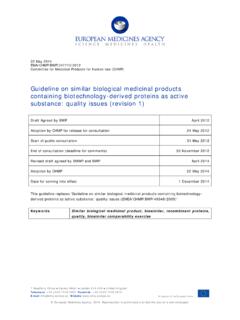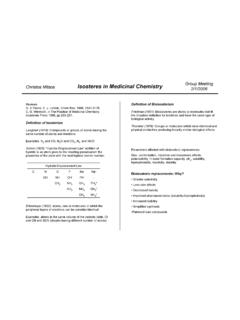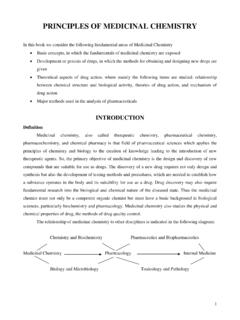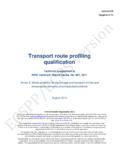Transcription of Guideline on similar biological medicinal products ...
1 30 Churchill Place Canary Wharf London E14 5EU United Kingdom An agency of the European Union Telephone +44 (0)20 3660 6000 Facsimile +44 (0)20 3660 5555 Send a question via our website European Medicines Agency, 2015. Reproduction is authorised provided the source is acknowledged. 18 December 2014 EMEA/CHMP/BMWP/42832/2005 Rev1 Committee for medicinal products for Human Use (CHMP) Guideline on similar biological medicinal products containing biotechnology-derived proteins as active substance: non-clinical and clinical issues Draft agreed by Biosimilar medicinal products Working Party (BMWP) April 2013 Adopted by CHMP for release for consultation 30 May 2013 Start of public consultation 03 June 2013 End of consultation (deadline for comments) 30 November 2013 Agreed by Biosimilar medicinal products Working Party (BMWP) October 2014 Adopted by CHMP 18 December 2014 Date for coming into effect 01 July 2015 This Guideline replaces ' Guideline on similar biological medicinal products containing biotechnology-derived proteins as active substance: Non-clinical and clinical issues' (EMEA/CHMP/BMWP/42832/2005).
2 Keywords similar biological medicinal product, recombinant proteins, non-clinical studies, clinical studies, safety, pharmacovigilance, immunogenicity Guideline on similar biological medicinal products containing biotechnology-derived proteins as active substance: non-clinical and clinical issues EMEA/CHMP/BMWP/42832/2005 Rev1 Page 2/13 Guideline on similar biological medicinal products containing biotechnology-derived proteins as active substance: non-clinical and clinical issues Table of contents Executive summary .. 3 1. Introduction .. 3 2. 4 3. Legal basis and relevant guidelines .. 4 4. Non-clinical studies .. 5 Step 1: In vitro studies .. 5 Step 2: Determination of the need for in vivo studies .. 6 Step 3: In vivo studies .. 6 5. Clinical studies .. 7 Pharmacokinetic studies .. 8 Pharmacodynamic studies .. 9 Efficacy trials .. 9 Study designs .. 10 Efficacy endpoints .. 10 Clinical safety .. 11 6. Extrapolation of efficacy and safety from one therapeutic indication to another.
3 12 7. Pharmacovigilance .. 12 Guideline on similar biological medicinal products containing biotechnology-derived proteins as active substance: non-clinical and clinical issues EMEA/CHMP/BMWP/42832/2005 Rev1 Page 3/13 Executive summary The Guideline on similar biological medicinal products containing biotechnology-derived proteins as active substance: non-clinical and clinical issues (EMEA/CHMP/BMWP/42832/05 ) lays down the non-clinical and clinical requirements for a similar biological medicinal product ( biosimilar ). The non-clinical section addresses the pharmaco-toxicological assessment. The clinical section addresses the requirements for pharmacokinetic, pharmacodynamic, and efficacy studies. The section on clinical safety and pharmacovigilance addresses clinical safety studies, including immunogenicity, as well as the risk management plan. The current revision covers the following topics: a stepwise approach for the design of non-clinical studies; the use of pharmacodynamic markers; study design, choice of appropriate patient population and choice of surrogate and clinical endpoints in efficacy trials; clinical safety (including design of immunogenicity studies), risk management plan, and pharmacovigilance, and extrapolation of safety and efficacy.
4 The Guideline recommends a stepwise conduct of non-clinical and clinical studies. 1. Introduction A biosimilar is a biological medicinal product that contains a version of the active substance of an already authorised original biological medicinal product (reference medicinal product) in the European Economic Area (EEA). Similarity to the reference medicinal product in terms of quality characteristics, biological activity, safety and efficacy based on a comprehensive comparability exercise needs to be established. The Marketing Authorisation (MA) application dossier of a biosimilar medicinal product shall provide a full quality dossier together with data demonstrating comparability with the reference medicinal product by using appropriate physico-chemical and in vitro biological tests, non-clinical studies and clinical studies. The quality issues relevant for demonstration of biosimilar comparability are addressed in the Guideline on similar biological medicinal products containing biotechnology-derived proteins as active substances: quality issues (EMA/CHMP/BWP/247713/2012).
5 The principles for the non-clinical and clinical parts of the biosimilar comparability exercise are laid down in this Guideline . Product class specific guidelines will supplement this Guideline where a need is identified. The nature and complexity of the reference product have an impact on the extent of the (non)clinical studies to confirm biosimilarity. The differences observed in the physico-chemical and biological analyses will guide the planning of the (non-)clinical studies. Other factors that need to be taken into consideration are the mode of action of the active substance ( receptor(s) involved) in all the authorised indications of the reference product and pathogenic mechanisms involved in the disorders included in the therapeutic indications ( mechanisms shared by various therapeutic indications) as well as the immunogenicity of the reference medicinal product. The applicant should review data from the reference product on the predictive value of in vitro assays/animal models as well as correlations between dose/exposure and pharmacodynamics.
6 In addition, the applicant should look at the correlation between pharmacodynamics and clinical response. The availability of suitable biomarkers may abbreviate the (non-)clinical development. The safety profile of the reference product will mainly determine the focus of the clinical safety studies both pre- and post-authorisation. Guideline on similar biological medicinal products containing biotechnology-derived proteins as active substance: non-clinical and clinical issues EMEA/CHMP/BMWP/42832/2005 Rev1 Page 4/13 If the biosimilar comparability exercise indicates that there are relevant differences between the biosimilar and the reference medicinal product, making it unlikely that biosimilarity will eventually be established, a stand-alone development to support a full Marketing Authorisation Application, should be considered instead (see Guideline on similar biological products (CHMP/437/04 Rev. 1)). 2. Scope This Guideline addresses the general principles for the non-clinical and clinical development and assessment of the marketing authorisation applications of biosimilars containing biotechnology-derived proteins as active substance(s).
7 Nevertheless, the principles explained in this document could apply to other biological products , on a case by case basis. This Guideline does not address the comparability exercise for changes introduced in the manufacturing process of a given product ( changes during development and post-authorisation). 3. Legal basis and relevant guidelines Directive 2001/83/EC, as amended in particular Directive 2001/83/EC Art 10(4) and Part II of the Annex I of Directive 2001/83/EC, as amended. Directive 2010/63/EU on the protection of animals used for scientific purposes. For the relevant CHMP/ICH guidelines, please see the website of the European medicines Agency ( ): Human medicines > Scientific guidelines > Multidisciplinary > Biosimilar. In particular, the following guidelines should be read in conjunction: Guideline on similar biological products (CHMP/437/04 Rev. 1), the so-called overarching Guideline Guideline on similar biological medicinal products containing biotechnology-derived proteins as active substance quality issues (EMA/CHMP/BWP/247713/2012) Q5E Comparability of biotechnological/ biological products (CPMP/ICH/5721/03) ICH topic E9 statistical principles for clinical trials Note for guidance on statistical principles for clinical trials (CPMP/ICH/363/96) Guideline on the choice of the non-inferiority margin (CPMP/EWP/2158/99) ICH topic E10 - Note for guidance on choice of control group in clinical trials (CPMP/ICH/364/96) Guideline on Immunogenicity assessment of biotechnology-derived therapeutic proteins (EMEA/CHMP/BMWP/14327/2006) Guideline on Immunogenicity assessment of monoclonal antibodies intended for in vivo clinical use (EMA/CHMP/BMWP/86289/2010)
8 Guideline on the clinical investigation of the pharmacokinetics of therapeutic proteins (CHMP/EWP/89249/2004) Guideline on the investigation of bioequivalence (CPMP/EWP/QWP/1401/98 Rev. 1/ Corr) Guideline on bioanalytical method validation (EMEA/CHMP/EWP/192217/2009) Product class-specific guidelines on various biosimilar products Guideline on similar biological medicinal products containing biotechnology-derived proteins as active substance: non-clinical and clinical issues EMEA/CHMP/BMWP/42832/2005 Rev1 Page 5/13 Guidelines on good pharmacovigilance practices (please see the website of the European medicines Agency ( ) Human regulatory Pharmacovigilance Good Pharmacovigilance Practices) 4. Non-clinical studies To support biosimilarity, relevant non-clinical studies should be performed before initiating clinical trials. A stepwise approach is recommended for evaluation of the similarity of the biosimilar and the reference product.
9 Analytical studies (see Guideline on similar biological medicinal products containing biotechnology-derived proteins as active substance quality issues) and in vitro pharmaco-toxicological studies should be conducted first and a decision then made as to the extent of what, if any, in vivo work in animal studies will be required. It is important to note that, to design an appropriate non-clinical study programme, a clear understanding of the reference product characteristics is required. Results from the physico-chemical and biological characterisation studies ( comparability of the biosimilar to the reference product) should be reviewed from the point-of-view of potential impact on efficacy and safety. The following approach may be considered and should be tailored to the product concerned on a case-by-case basis. The approach taken will need to be fully justified in the non-clinical overview. Step 1: In vitro studies In order to assess any potential difference in biological activity between the biosimilar and the reference medicinal product, data from a number of comparative in vitro studies, some of which may already be available from quality-related assays, should normally be provided.
10 These studies should include relevant assays on: - Binding to target(s) ( receptors, antigens, enzymes) known to be involved in the pharmaco-toxicological effects and/or pharmacokinetics of the reference product. - Signal transduction and functional activity/viability of cells known to be of relevance for the pharmaco-toxicological effects of the reference product. The studies should be comparative in nature and should not just assess the response per se. To obtain unambiguous results, the methods used should be scientifically valid and suitable for their purpose. The studies should be sensitive, specific and sufficiently discriminatory to provide evidence that observed differences in quality attributes are clinically not relevant. The studies should compare the concentration activity/binding relationship of the biosimilar and the reference medicinal product at the pharmacological target(s), covering a concentration range where potential differences are most sensitively detected.
















